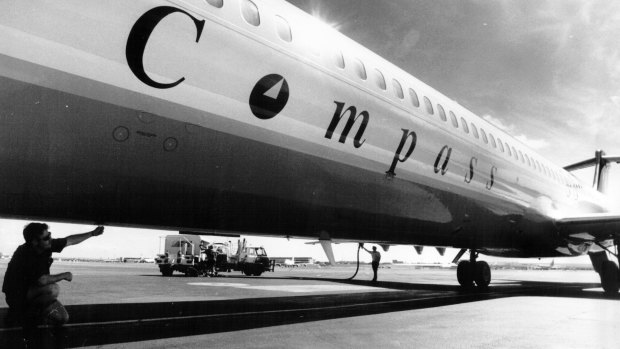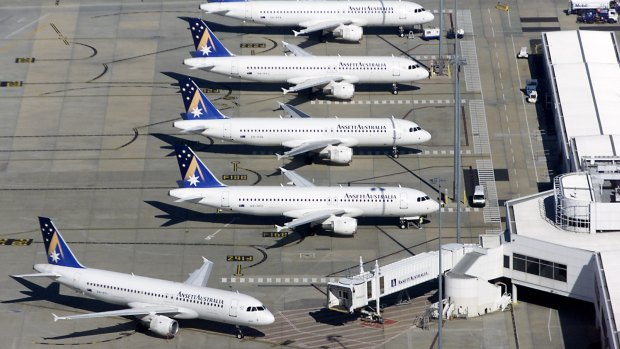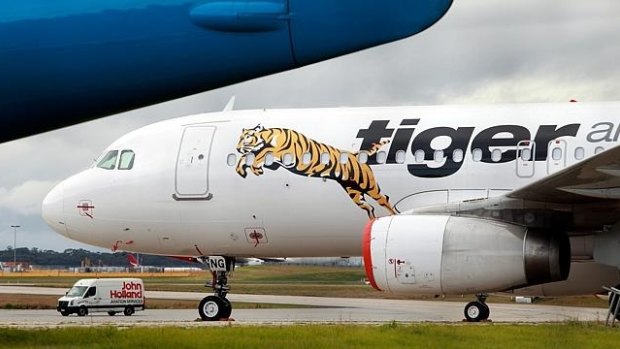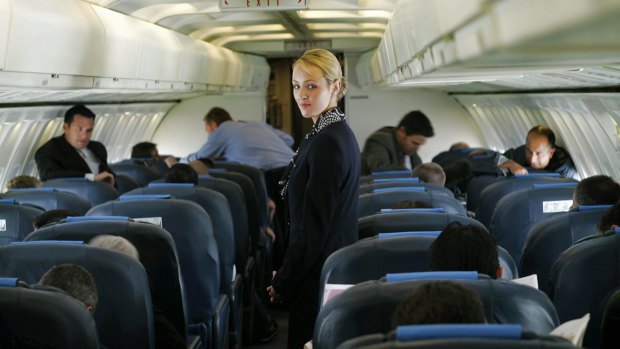
Compass was hobbled from the time it took to the air in 1990.Credit: Bruce Miller
It's tough operating an airline in Australia's skies, as Bonza is finding out. Australia's latest airline promises to be a boon for regional travel across east coast Australia, but Bonza has been repeatedly stalled in its efforts to get airborne.
After promising services starting in mid-2022, later revised to September, the airline is yet to carry its first passenger, currently waiting on its Air Operator's Certificate to be signed off by the Civil Aviation Safety Authority (CASA). Meanwhile Bonza's three Boeing 737 MAX 8 aircraft, "Bazza", "Shazza" and "Sheila", are sitting idle at the airline's Sunshine Coast base.
Australia's aviation industry is peppered with airlines that failed to survive in the long term, facing tough competition from the established players who from time to time have been aided and abetted by the Australian government to ensure that rivals are not allowed to prosper.
Compass, Australia's first low-cost airline begins operations, 1990
Until the early 1990s Australia had a government-mandated two-airline policy. The two domestic airlines – Ansett and Australian Airlines – operated a duopoly, charging the same fares, with similar sized fleets operating mainly on the same inter-city routes. East-West Airlines was an early upstart that tried to muscle in with cheaper airfares but the government stepped in and punted the carrier to regional routes.
In October 1990, the Hawke government deregulated the airline industry with the aim of offering passengers greater flexibility and allowing free market forces to set prices. That opened the door to low-price competition, and a month later Compass Airlines, Australia's first low-cost airline, commenced operations.
A successful low-cost competitor was a potential nightmare for the Ansett-Australian cartel and Compass was hobbled from the time it took to the air.
In Brisbane, Sydney, Melbourne, Perth and Adelaide, Compass was forced to use the terminals of its competitors, which consigned its aircraft to the Siberia of boarding gates. On routes on which Compass was competing, the major carriers simply dropped fares – and they could sustain losses far longer than Compass.
The nail in the Compass coffin was a dispute between the airline and the CASA over fees, and on 20 December 1991 Compass was grounded, immediately before the peak Christmas period. The revenue from that period might have bolstered the airline's war chest sufficiently to allow it to keep operating. The following year, an attempted re-start of Compass Mark II, originally Southern Cross Airlines, foundered after just six months, forced into liquidation by unsustainable losses.
Ansett hits the skids, 2001

Founded in 1935 by "Reg" Ansett as a sideline to his Victorian road transport operation, Ansett Australia was once Australia's largest domestic carrier, and the first to operate jet-powered aircraft on domestic routes.
Growth was steady. At its peak Ansett operated a fleet of over 100 aircraft, with services throughout Asia and the Pacific, but its demise came quickly.
Early in 2000, Air New Zealand took full control of Ansett, buying out News Corporation's share, having already acquired Peter Abeles' TNT share of the airline. The move was intended to shore up the NZ national carrier.
New Zealand had previously opened its skies to Ansett, which saw the establishment of Ansett New Zealand, but under pressure from Australia's domestic carriers the Howard government reneged on a deal to allow Air New Zealand to establish a presence in Australia's domestic market.
Ansett had boomed over the previous two decades, but the airline was facing headwinds. The Ansett fleet consisted of more than 15 aircraft types, from Fokker Friendships to DeHavilland Twin Otters to five Boeing 747s. As well as complicating maintenance, some of these aircraft, such as its 13 Boeing 767s, were well past their use-by date.
Competition from low-cost Virgin Blue was impacting its revenue stream, particularly on the lucrative Melbourne-Sydney route. A series of imprudent financial decisions made under the previous TNT-News Corp ownership – building Hamilton Island Resort, a multimillion dollar bid to become the official carrier for the 2000 Sydney Olympics – saddled the airline with debt. The general decline in air traffic following the attack September 11, 2001 terrorist attacks in the US was yet another blow.
Shortly after Air New Zealand took control, Ansett was losing $1.3 million per day, and its parent was unable to sustain the loss. With debts of $3 billion, Ansett was placed in administration on behalf of creditors in September 2001.
Tigerair Australia, a pandemic victim, 2020

Credit: Rebecca Hallas
Tigerair operated its first flights in Australia in November 2007 as Tiger Airways Australia, owned by a Singapore-based holding company behind several low-cost Asia-Pacific airlines. Tiger prospered on the strength of its amazingly low fares, operating up to nine flights per day each way between Sydney and Melbourne, although it engendered little love, introducing Australian travellers to ancillary charges such as a fee for checked luggage, concepts that had underwritten the profitability of overseas low-cost carriers.
Seeing the airline emerge as a competitor, Virgin Australia Holdings snuffed it with a takeover bid, becoming a majority shareholder in July 2013, after the airline had changed its name to Tigerair Australia. The following year Virgin Australia took full control, and Tigerair became Virgin's low-cost arm, the competitor for Qantas' Jetstar.
For a brief time Tigerair operated services from Melbourne, Adelaide and Perth to Bali and Denpasar. In February 2020 Virgin Australia announced its intention to downsize Tigerair's fleet from 13 to eight aircraft, suspend five loss-making routes and close its Brisbane base.
The following month, hit by COVID-19 travel restrictions, Tigerair suspended operations. Parent Virgin Australia was struggling for the same reason, and a few months later Bain Capital was announced as the preferred buyer for both Virgin Australia and Tigerair. In mid-2020 Virgin Australia announced that Tigerair would not be resuming operations, although it would retain its Air Operator Certificate in case market conditions should allow the resumption of the ultra-low-cost carrier.
OzJet, the brave business airline

Sign up for the Traveller newsletter
The latest travel news, tips and inspiration delivered to your inbox. Sign up now.